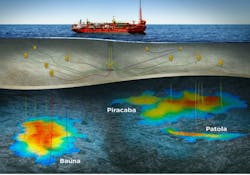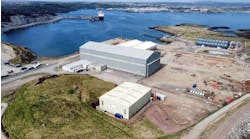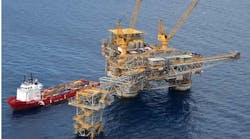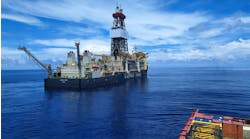Aker BP and partners ConocoPhillips and Lundin Energy have submitted a plan for development and operation for the Kobra East & Gekko (KEG) project in the northern Norwegian North Sea. The development, designed to recover around 40 MMboe, will help extend the lifetime of the host FPSO Alvheim through 2040.
Operator Aker BP estimates total investments in the project at about $1 billion and a breakeven cost of less than $30/bbl. Start-up is targeted for 1Q 2024.
The development, encompassing the Kobra East and Gekko discoveries, will involve an 8-km (5-mi) subsea tieback to the FPSO Alvheim.
Aker Solutions will deliver the subsea production system. This will include four horizontal subsea trees, three manifolds, control systems, three static subsea umbilicals, and associated tie-in equipment and installation work. Work will involve the company’s facilities in Brazil, Malaysia, Norway, and the UK. Final deliveries are scheduled for 1Q 2023.
Subsea 7 is responsible for engineering of the subsea tieback, which will connect to the Kneler B subsea manifold. Its EPCI scope covers the pipelines, spools, protection cover and tie-ins using vessels from the company’s fleet. The production pipeline will be a pipe-in-pipe design.
Subsea 7’s offices in Stavanger will handle project management and engineering, with fabrication of the pipelines performed at the company’s spoolbase at Vigra, Norway. Offshore operations are expected to take place during 2022 and 2023.
OKEA has approved its first operated field development offshore Norway. The company and partners Petoro and Neptune Energy plan to tieback the Hasselmus gas discovery to the Draugen production platform in the Norwegian Sea via a single subsea well. This will be the first tieback to the facility.
Hasselmus should produce 10.6 MMboe as fuel and export gas, also allowing exports to resume of associated gas including NGL, currently injected into the Draugen reservoir.
OKEA estimates project costs at NOK2.4 billion ($290 million). Start-up is targeted for 4Q 2023.
The Subsea Integration Alliance of Subsea 7 and OneSubsea is responsible for engineering, procurement, construction, and installation of the subsea production systems and subsea pipelines (SURF). The SURF scope covers around 9 km (5.6 mi) of pipe-in-pipe flowline and associated structures in water depths of around 250 m (820 ft).
Project management and engineering has started at Subsea 7’s offices in Stavanger. Fabrication of the pipelines will take place at its spoolbase at Vigra, Norway. Offshore operations are expected to take place during 2022 and 2023.
Karoon Energy has committed to develop the Patola field in the Santos basin offshore Brazil.
Patola, in 300 m (984 ft) of water in license BM-S-40, is adjacent to the producing Baúna and Piracaba accumulations. Two near-vertical subsea production wells will be tied back to spare riser slots on the FPSO Cidade de Itajaí at the Baúna field.
TechnipFMC will design, manufacture, and install the x-mas trees, flowlines, risers, umbilical, and controls under an integrated EPCI contract, scheduled for completion during 2H 2022.
Karoon estimates the cost of the development at $175-195 million.
Patola, due to come onstream early in 2023, should initially produce more than 10,000 b/d from reservoirs of the same geological age as those in Baúna and Piracaba. The development will target 14.7 MMbbl of 2C resources, comprising 13.2 MMbbl in Patola and an additional 1.5 MMbbl in Baúna arising from injecting Patola’s gas into the Baúna reservoir.
Equinor has contracted the Subsea Integration Alliance to provide the subsea equipment network for the Bacalhau development offshore Brazil. Bacalhau is said to be Brazil’s first integrated SURF/SPS project. The location is 185 km (115 mi) from the coast of São Paulo State in the presalt Santos basin, in a water depth of about 2,050 m (6,726 ft).
The workscope covers EPCI of the subsea pipelines and production systems, with 140 km (87 mi) of rigid risers and flowlines, 40 km (25 mi) of umbilicals, 19 trees and associated equipment.
The Subsea Integration Alliance team, established during the initial FEED phase awarded in January 2020, will stay together for the full EPCI campaign with project management and detailed engineering performed in Rio de Janeiro, supported by Subsea 7’s Global Project Centre bases in the UK and France and various OneSubsea offices.
Offshore activities will take place from 2022 to 2023 using Subsea 7 reel-lay, flex-lay and light construction vessels.
Siemens Energy will supply pressure and temperature sensors for the subsea production system, electrical distribution equipment including flying leads, umbilical terminations, and connectors for subsea modules, and multi-leg harness assemblies. The pressure and temperature sensors will provide monitoring data for the production system on the seabed. The subsea connectors form part of the distribution system and will provide low voltage power and communications to the subsea xmas tree production system. Installation and commissioning of the equipment are slated for 2022 and 2024.
Nexans will manufacture 2.5 km (1.6 mi) of gas-lift umbilicals, 35 km (22 mi) of static umbilicals, 6.9 km (4.3 mi) of dynamic umbilicals and accessories at its facility in Halden, Norway. The umbilicals are scheduled to be delivered in 4Q 2022.
The Bacalhau development calls for 19 subsea wells tied back to one of Brazil’s largest FPSOs, which MODEC is delivering. First oil is targeted for 2024. Partners in the project are Equinor (operator), ExxonMobil, Petrogal, and Pré-sal Petróleo.





